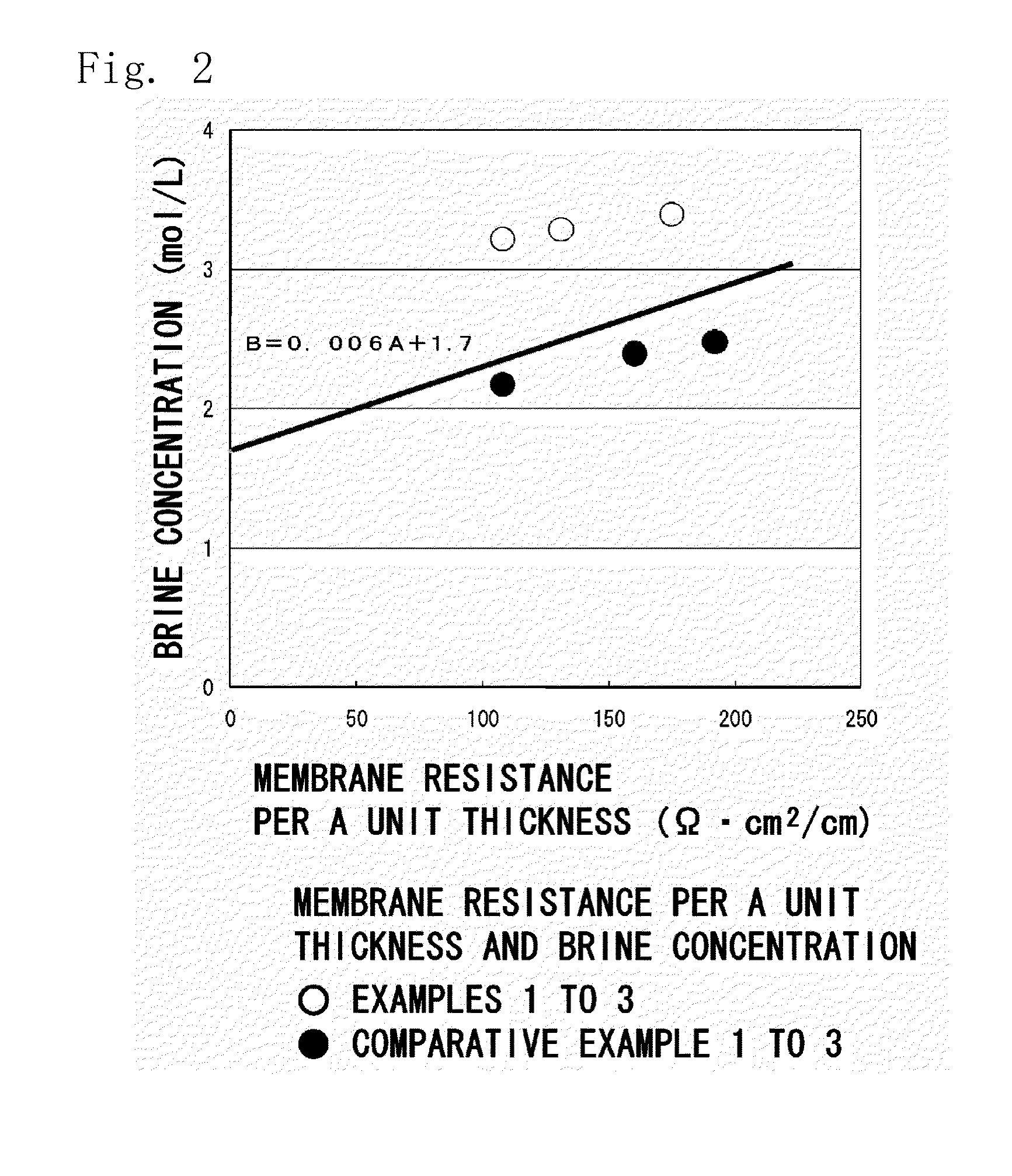Ion-exchange membrane
a technology of exchange membrane and ion exchange membrane, which is applied in the direction of refrigeration components, electrodialysis, refrigeration machines, etc., can solve the problems of loss of strength or deformation, and achieve the effect of improving concentration property, excellent concentration property, and easy to increase thickness
- Summary
- Abstract
- Description
- Claims
- Application Information
AI Technical Summary
Benefits of technology
Problems solved by technology
Method used
Image
Examples
example 1
[0109]82.5 parts by weight of a styrene, 17.5 parts by weight of a divinylbenzene (purity of 57%), 5 parts by weight of a dibutyl phthalate and 2 parts by weight of a perbutyl O (t-butylperoxy-2-ethyl hexanoate, manufactured by Nihon Yushi Co.) were mixed together to prepare a polymerizable composition.
[0110]500 Grams of the polymerizable composition was put into a 1000-ml glass container and in which the porous unstretched polyethylene sheet prepared in the Preparation Example 1 was dipped as the base sheet so that the pores in the sheet was filled with the polymerizable composition.
[0111]The porous unstretched polyethylene sheet filled with the polymerizable composition was taken out, covered on both sides thereof with a polyester film of a thickness of 100 μm as a peeling member, and was heat-polymerized under a nitrogen pressure of 0.4 MPa for 5 hours at 80° C. and for another 2 hours at 90° C.
[0112]The obtained membrane was dipped in a mixture of sulfuric acid of a concentratio...
examples 2 and 3
[0115]Cation-exchange membranes were obtained in the same manner as in Example 1 but using the porous unstretched polyethylene sheet obtained in Preparation Example 1 and using the styrene and the DVB (purity of 57%) in amounts as shown in Table 1. Properties of the obtained cation-exchange membrane and the measured results thereof were as shown in Table 1.
example 4
[0117]89.5 parts by weight of a chloromethylstyrene, 10.5 parts by weight of a divinylbenzene (purity of 57%), 2 parts by weight of a styrene oxide and 4 parts by weight of a perbutyl O were mixed together to prepare a polymerizable composition.
[0118]500 Grams of the polymerizable composition was put into a 1000-ml glass container and in which the porous unstretched polyethylene sheet prepared in the Preparation Example 1 was dipped as the base sheet so that, the pores in the sheet were filled with the polymerizable composition.
[0119]The porous unstretched polyethylene sheet filled with the polymerizable composition was taken out, covered on both sides thereof with a 100-μm polyester film as a peeling member, and was heat-polymerized under a nitrogen pressure of 0.4 MPa for 5 hours at 80° C. and for another 2 hours at 90° C.
[0120]The obtained membrane was dipped in a mixture of 15 parts by weight of a 30% trimethylamine aqueous solution, 52.5 parts by weight of water and 22.5 parts ...
PUM
| Property | Measurement | Unit |
|---|---|---|
| porosity | aaaaa | aaaaa |
| thickness | aaaaa | aaaaa |
| tensile elongations | aaaaa | aaaaa |
Abstract
Description
Claims
Application Information
 Login to View More
Login to View More - R&D
- Intellectual Property
- Life Sciences
- Materials
- Tech Scout
- Unparalleled Data Quality
- Higher Quality Content
- 60% Fewer Hallucinations
Browse by: Latest US Patents, China's latest patents, Technical Efficacy Thesaurus, Application Domain, Technology Topic, Popular Technical Reports.
© 2025 PatSnap. All rights reserved.Legal|Privacy policy|Modern Slavery Act Transparency Statement|Sitemap|About US| Contact US: help@patsnap.com



